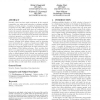Free Online Productivity Tools
i2Speak
i2Symbol
i2OCR
iTex2Img
iWeb2Print
iWeb2Shot
i2Type
iPdf2Split
iPdf2Merge
i2Bopomofo
i2Arabic
i2Style
i2Image
i2PDF
iLatex2Rtf
Sci2ools
128
Voted
SIGCOMM
2010
ACM
2010
ACM
An analysis of social network-based Sybil defenses
Recently, there has been much excitement in the research community over using social networks to mitigate multiple identity, or Sybil, attacks. A number of schemes have been proposed, but they differ greatly in the algorithms they use and in the networks upon which they are evaluated. As a result, the research community lacks a clear understanding of how these schemes compare against each other, how well they would work on real-world social networks with different structural properties, or whether there exist other (potentially better) ways of Sybil defense. In this paper, we show that, despite their considerable differences, existing Sybil defense schemes work by detecting local communities (i.e., clusters of nodes more tightly knit than the rest of the graph) around a trusted node. Our finding has important implications for both existing and future designs of Sybil defense schemes. First, we show that there is an opportunity to leverage the substantial amount of prior work on genera...
| Added | 06 Dec 2010 |
| Updated | 06 Dec 2010 |
| Type | Conference |
| Year | 2010 |
| Where | SIGCOMM |
| Authors | Bimal Viswanath, Ansley Post, P. Krishna Gummadi, Alan Mislove |
Comments (0)

